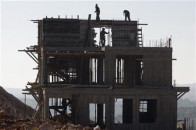Korea ready to give Karachi ‘Gangnam Style’
Few people are aware of how Gangnam - a chunk of farmland in Korea – was behind a new way of urbanisation for Seoul.

Few people are aware of how Gangnam - a chunk of farmland in Korea – was behind a new way of urbanisation for Seoul. CREATIVE COMMON
Today, every Korean dreams of living in Gangnam district.
“Gangnam was once a farmland and there was nothing special about it until it became a district of Seoul under the new town development scheme,” revealed Dr Jinchoel Jo in his presentation on the ‘Case of Korea and its implications for Pakistan.’
He along with other speakers, including Rabia Ezdi, Ziaul Islam, Sidrat Asim, Faiza Sarwar and Jamil Kazmi, Tauqeer Ahmed and Tehseen Ahmed, were speaking at the South Asian Cities Conference here at Frere Hall on Friday.
From 1983 and 1993, around two million housing construction projects were started in the five new towns that were added as districts in Seoul. “Because of the development projects, Gangnam district is as famous as Gangnam Style now all over the world,” said Dr Jo.
The city was intentionally expanded while keeping economic growth in view because of the growing population. Industries were transformed from labour-intensive to capital-intensive ones. Dr Jo was also quick to add that Korea was now converting to ‘Green’ industry. “Planning is very important in this regard. In Korea, people are living in good houses and there are literally no slum areas anymore.”
Linking the growth with Karachi’s future, Dr Jo said that through new town development, while keeping urban infrastructure, green belts, disaster management and transportation in view, the metropolis city can become a city like Seoul. “All this city needs is the Gangnam Style.”
He cautioned that the new towns should not be built far from the current city, otherwise the purpose will not be fulfilled. Korean experts were ready, he added, to help in terms of development plans and capacity building in Karachi.
Pro-poor policies
For her part, Rabia Ezdi said that the process of expropriation should not be completed on the basis of the formula ‘accumulation by dispossession’ as reflected in the anti-poor policies of the government. Take Lahore’s peri-urban villages and their private housing development and its repercussions for villagers. So far 35 to 40 villages have been converted into developed societies over the years.
She was of the view that there was nothing wrong with rapid development but it should be done in a way that the villagers do not end up as domestic labourers in the same societies even after selling their land.
While defining vertical residential development, Tauqeer Ahmed said that when people can’t afford to buy land, they are compelled to live in slums. Ahmed, however, said that vertical residential projects can fulfil the requirements of many as they are acceptable, affordable, adoptable and achievable.
In her presentation on water-use habits in Karachi, Sidrat Asim told the audience that clean drinking water remains the greatest perceived need of the people of Karachi. Asim revealed that only 354,573 residents of the city have water connections, which was just the 58 percent of the total. “The other 42 percent have no official water supply,” she said.
Asim chose two blocks, four and seven, of the densely populated Gulshan-e-Iqbal for her research. While highlighting her ‘averting expenditures approach,’ she said that Karachi has exceeded the population of Mumbai but it has only four hours of continuous water supply, which led to the rule of the tanker mafia. “Water demand is estimated at 1,080 million gallons daily,” she said and it can only be met by charging in accordance with the residential area one possesses.
Faiza Sarwar and Jamil Kazmi presented on a GIS-based analysis of essential creeks habitat in supporting marine fisheries of the Sindh coast. We were living near a sea, they said, but have no sea-food culture, which if we included in our lives can help people make a fortune.



















COMMENTS
Comments are moderated and generally will be posted if they are on-topic and not abusive.
For more information, please see our Comments FAQ